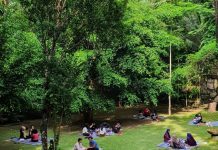Eating as one of the basic human needs has a kind of ritual that is not only can be done at home with family but also in the restaurant. Sometimes, eating in the restaurant is a refresher to strengthen the communication between family members. Meanwhile, economic calculations are not the main problems because the initial intention is to get new experiences together. The journey to the place to eat was even more beautiful and full of memories.
Warung Sego Nggeneng Mbah Marto is one of the reference places for culinary activities and getting new experience during the trip to the location of the stall. There is no information board as a guide to reach this place. Therefore, it is a challenge for culinary hunters to get a new sensation and experience during the trip to Sego Nggeneng Mbah Marto stall. This food stall owned by Mbah Martodiryo or Mbah Marto Gowok who was 80 years old.

To reach Sego Nggeneng Mbah Marto stall from Yogyakarta, you need to go south following Jl. Parangtritis. After arrive at Indonesian Art Institute’s crossroad, turn right to the Nengahan Village. Besides that, you can take an alternative route to reach this stall. From Jl. Parangtritis km.7, there is a small alley on the west side of the road near Cemani Numai Restaurant. Then, follow the path in the alley until you reach a T-junction in a Projotamansari monument that leads to a mosque. You can park your vehicle when driving a car in the courtyard of this mosque.
Gudeg with areh (not thick) and green papaya leaves is a classic menu that served in Sego Nggeneng Mbah Marto. For the sambal (chili souse) using kacang tholo (red beans) that cooked spicy with krecek (kind of crackers). This place also provides various kinds of side dishes ranging from tofu, tempeh, eggs, the chicken liver that is cooked using bumbu besengek (roasted spices) and mangut lele (spicy curry catfish).

Furthermore, another uniqueness of Sego Nggeneng Mbah Marto is the customers can enter the kitchen directly to take the food, and choose where the seating to eat. The wall in the kitchen filled with soot making the atmosphere of this kitchen is far from being clean. In this place, the owner cooking uses a traditional stove (Keren).
In Sego Nggeneng Mbah Marto, how to cook mangut lele is different from another place. Before the cooking process, the catfishes are cleaned and wrapped using the banana leaf. Then, it smoked on the fire from coconut fibers that burned. The use of banana leaf makes the catfish not sticky, chewy, and its taste is delicious. After that, the catfish put into mangut (spicy curry) spices and cooked until the spices soak in the traditional stove.

The uniqueness of this stall is the customers free to choose the seat provided. Besides that, there is no room that arranged like in the other food stall as usual. The customers can choose to eat on the terrace of the house, living room or kitchen. There is no limit between the customers and the owner. The familiarity of this place is a strong characteristic that increasing brotherhood between the customers.



